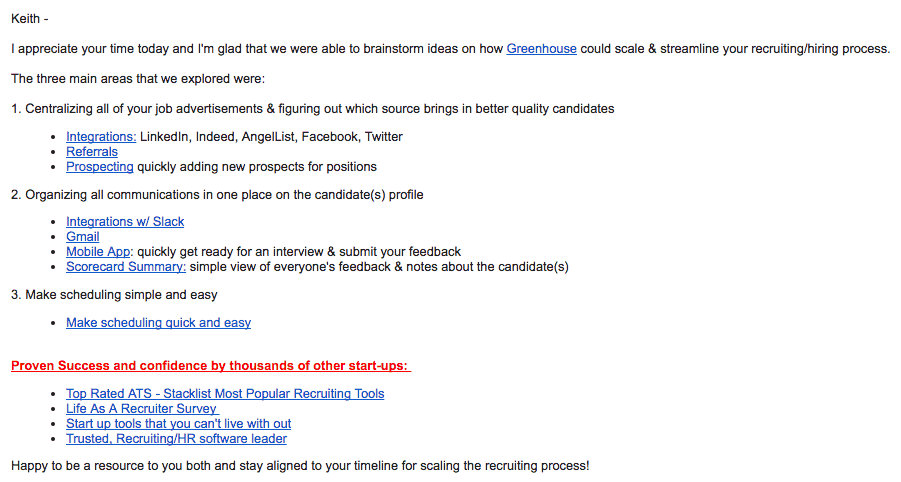
Look, I’ll come clean:
I’ve written a lot over the past year about the limitations of email, and how today’s buyers are now spending more time using messaging.
But here’s the thing:
While people have been predicting email’s demise since 2004, it’s clearly still alive and kicking. Marketing and sales teams all around the world are still using email to drive results.
And if you’re one of the 15,000 people who subscribe to our newsletter, you know that we use email here at Drift on a regular basis.
The tricky part — and this is probably going to sound ridiculously obvious — is writing emails that people actually feel compelled to open and read.
How to Write Marketing Emails Your Leads Will Actually Open
As Terminus CMO Sangram Vajre told us in a recent interview, in the early days of email marketing, open rates could soar as high as 85% to 95%.
Today, the average email open rate is just above 20%.
With email being such a saturated marketing channel, finding a way to have your emails rise above the noise is crucial.
The good news is that we’ve developed a little trick here at Drift for figuring out what makes a compelling email:
We look at the emails our CEO decides to open and read.
Here’s why:
Our CEO (David Cancel) gets a bajillion emails everyday. He could spend the rest of his life opening emails.
So why does he take the time to open and read the emails that he does?
In this post, I’ll highlight three emails that our CEO loved and explore what we can learn from them.
1) The Social Proof Email
Subject line: Discover why 100,000+ customers are using Zendesk

Why our CEO loved it:
When David forwarded this email to the marketing team, he included just one sentence of commentary:
“Now that’s a subject line.”
This email was a case of love at first sight: David read the subject line and was immediately hooked. And that’s not an easy thing to pull off when you consider how many other email subject lines it was competing against.
What we learned from it:
Social proof is a powerful psychological trigger.
When we see that lots of people are using a particular product (or joining a particular group, or watching a particular TV show, etc.), it influences our behavior. We’re more likely to think something’s a good idea when we know a lot of other people are already doing it.
This is a concept marketing professor Jonah Berger wrote about it in his book Contagious: Why Things Catch On.
In the book, he gives the example of how anti-drug ads from the ‘90s, which drew attention to the high numbers of teens using drugs, probably led to more drug usage among teens, not less. That’s because by making public the fact that so many people were engaging in this behavior, they inadvertently normalized it.
Think about observability and social proof. Before seeing the message, some kids might never have thought about taking drugs. Others might have considered it but have been wary about doing the wrong thing… The more others seem to be doing something, the more likely people are to think that thing is right or normal and what they should be doing as well.
When you think back to the email my CEO got, the same principles apply.
David might not have ever thought about using that particular product before, but now that he knows a hundred thousand people are using it, maybe he’ll consider it.
Or, let’s say he had thought about using that product before, but he was hesitant because he wasn’t sure if it was the right move. Welp, now that he’s seen that it was the right move for a hundred thousand customers… that might change things.
At the very least, it got him to open the email.
That’s the power of social proof.
2) The Short & Sweet Email
Subject Line: FAQs are dead

Why our CEO loved it:
Couple a provocative headline with a message that’s short, sweet, and to the point, and you’ve got yourself an email that a CEO is likely to open and read.
That’s something I’ve always struggled with: condensing a product pitch or an idea or whatever it is down into a few, simple sentences that grab someone’s attention and get them wanting to learn more.
This email definitely pulled it off. (And that’s why our CEO forwarded it to us so we could take a look.)
What we learned from it:
A little hyperbole can go a long way.
Are the FAQ sections of websites really dead, as this email’s subject line proclaims?
Of course not. But that’s not the point.
The writer of this email used hyperbole intentionally. The point was never to convince the reader outright that FAQs have completely outlived their usefulness, but simply to get the reader to wonder: What might a world without FAQs look like?
The tone of the subject line carries over into the body of the email, where it becomes immediately apparent that the writer isn’t following the bland, impersonal business writing conventions of old.
“Hey Dave,” it begins, “Hope you’re having an awesome day!”
This opening reminded me of one of David Ogilvy’s ad copy writing tips:
Do not … address your readers as though they were gathered together in a stadium. When people read your copy, they are alone. Pretend you are writing to each of them a letter on behalf of your client.
A related tip is encapsulated in this shorter (easier to remember) Ogilvy quote:
Write the way you talk. Naturally.
After the email’s opening, three things happen in quick succession:
- You learn why the company is reaching out: “I wanted to check in and see…”
- You learn what that company does: “We’re building powerful tools…”
- You learn about what benefits you’re missing out on: “reduced support volume and increased customer satisfaction.”
And that reminds me of another pair of Ogilvy writing tips, which at first glance might seem paradoxical.
First, here’s Ogilvy on the importance of clearly explaining what it is you’re offering:
The more informative your advertising, the more persuasive it will be.
Second, here he is on the importance of being succinct:
Use short words, short sentences and short paragraphs.
The hard part, of course, is finding the balance between these two tips: getting a lot of information in a small amount of space.
3) The Resource Email
Subject Line: Greenhouse: recruiting easily done

Why our CEO loved it:
OK, so to be fair, our CEO didn’t get this email — at least not originally.
This one went to our recruiter, Keith, after he had completed a product demo.
But Keith liked the email so much that he forwarded it to David, and David liked it so much that he forwarded it to our VP of Sales with the following note attached:
“Armen, this post-demo email is f#@%ing solid”
The email offers an incredibly thorough recap of what was discussed in the demo, with links to resources and social proof. It’s like they were anticipating what Keith was going to ask next.
What we learned from it:
Once a lead has moved further down your sales funnel, and they’re actually digging into the nuts and bolts of your product, make it easy for them to find the resources that can help them.
This type of email is something your leads can keep referring back to as they continue to learn, and it empowers them to answer product questions on their own.
But what really makes this email work is how personalized it is:
All of the links provided — and there are a lot of them — relate back directly to the topics that were discussed in the demo.
So even though there isn’t a single, clear call-to-action in the email, it doesn’t matter. They’re trusting that Keith will read through the bulleted list of what they discussed and decide on his own what he wants to learn more about.
Looking for more email best practices?
Check out these three posts written by our director of marketing, Dave Gerhardt.
(FYI: the first one is exactly what it sounds like. Dave covers all of the emails we send here at Drift, from onboarding emails, to NPS emails, to abandonment emails.)
- Here Are All of the Emails We Send at Drift.
- The Huge Mistake We Had Been Making With Our Emails.
- What I Learned About Writing Copy From 146,693 Emails and 50 Blog Posts



